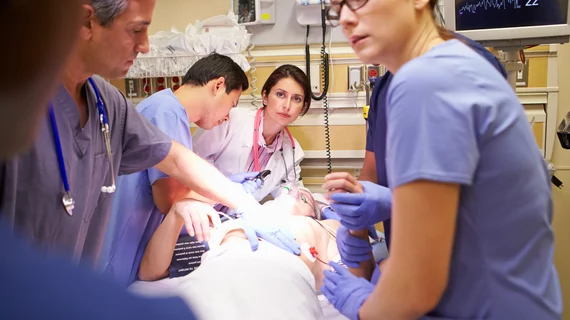Hiring ED expeditor improves CT workflow, decreases turnaround times
In the emergency department (ED), using a dedicated expeditor could improve CT imaging workflow, according to findings published Dec. 29 in the Journal of the American College of Radiology.
Researchers led by Soterios Gyftopoulos, MD, radiologist at New York University’s Langone Medical Center in New York City, found that adding the role to standard ED workflow decreased CT workup time by 35 percent and completion time by 22 percent, overall.
“Improving the turnaround times (TATs) of CT imaging could improve the efficiency of patient management in the ED by allowing for quicker patient triage and treatment allocation,” Gyftopoulos et al wrote.
To do this, the researchers decided that an ED-based radiology expeditor—a joint intervention developed by the radiology and emergency medicine departments at Langone—would be in the best position to facilitate pre-CT scan workflow and prioritize studies through direct conversation with the front ED provider and nursing time.
Before the start date, the expeditor—who did not have a clinical background—underwent a four-week long training program to understand current ED CT imaging workflow and steps needed to complete workup of exams, among other tasks.
For three months on weekdays from noon to 8 p.m., the expeditor was stationed in the ED patient area, prior to which all staff in the ED were notified about the new role and its function. The main responsibility of the expeditor was to facilitate easy communication with ED providers and coordinate workup needed for a patient to be cleared to undergo ED CT imaging.
Upon completion of the study, the researchers found that the ordered-to-scheduled TAT for noncontast, contrast and all CTs decreased by 50 percent, 25 percent and 35 percent, respectively. The team also observed a decrease in the ordered-to-completed TAT for non-contrast, contrast and all CTs by 24 percent, 18 percent and 22 percent, respectively. Additionally, the length of stay for patients treated and then released after their CT imaging decreased by four percent and for admitted patients by 12 percent.
Moreover, results from surveys sent to ED physicians by the researchers demonstrated that 75 percent of respondents found the expeditor improved the time it took to get an CT exam to the ED. Eighty percent of all respondents also thought that the expeditor role would be a valuable resource during additional ED shifts.
“Our ED expeditor was able to improve communication be- tween all of the important stake- holders by serving as the coordinator of the CT process while ensuring that all of the necessary information, such as clinical history, was available to complete imaging with the correct protocol in a timely manner,” the researchers noted.
“In addition, the positioning of the expeditor in the ED allowed for a better under- standing of the non-CT workflow factors, such as patient condition and location, and more direct communication with the ED teams that allowed for more appropriate patient prioritization.”
Due to the study’s success, the researchers are in the process of requesting funding for a permanent expeditor position. Additionally, they posited that there would have been continuous decreases in TATs if the expeditor and emergency medicine and radiology departments gained more experience working with each other and believed the tasks of the expeditor could also have been expanded to include other ED imaging modalities in addition to CT.
“We believe that an expanded version of this role, which includes the coordination of the other ED imaging modalities, has the potential to greatly improve the safety and efficiency of patient throughput in this clinical setting,” the researchers concluded.

